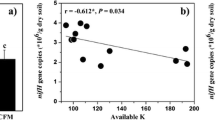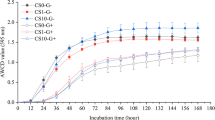Abstract
The potential ecotoxicologial risks of methamidophos, copper, and their combinations on microbial community of black soil ecosystem in the Northeast China were assessed in species richness and structures by using 16S rDNA-PCR-DGGE analysis approach, and functional characteristics at community levels by using BIOLOGGN system analysis method as well as two conventional methods(DHA and SIR). All results of DGGE banding fingerprint patterns(amplified by bacterial specific 16S rDNAV3 high variable region universal primer) indicated that the species richness of bacterial community in tested soil was significantly decreased to different extents by using different concentrations of single methamidophos, copper, especially some of their combinations had worse effects than their corresponding single factors. In addition, the structures of soil bacterial community had been disturbed under all stresses applied in this study because of the enrichment of some species and the disappearance of other species from the bacterial community. The effects of the single factors with lower concentrations on the community structure were weaker than those with higher concentrations. Moreover, the bacterial community structures under the combined stresses of methamidophos and copper were significantly different from those of control and their corresponding single factors. The change of DHA and carbon source substrate utilizing fingerprint patterns based on BIOLOGGNsystem were two relatively sensitive directors corresponding to the stress presented in this study. Between methamodophos and copper, there happened the significant joint-toxic actions when they were used in combination on DHA and carbon source substrate utilizing fingerprint patterns of soil bacterial communities. The DHA of soil under the combined stresses was lower than that of the control and that under the single factors, and the BIOLOGGN substrate utilizing patterns of soil treated by combinations were distinctively differentiated from the control and their corresponding single factors. From all of above, the methamidophos, copper, especially their combinations had the clearly potential ecotoxicological risks to influence the natural soil microbial ecological system by changing the structure, richness, and the functional characteristics of microbial community.
Similar content being viewed by others
References
Kennedy, A. C., Smith, K. L., Soil microbial diversity and the sustainability of agrochultural soils, Plants and Soil, 1995, 170: 75–86.
Finlay, B. J., Maberly, S. C., Cooper, J. I., Microbial diversity and ecological function, Oikos, 1997, 80: 209–213.
Groffman, P. M., Bohlen, P. J., Soil and sediment biodiversitycross-system comparisons and large-scale effects, BioScience, 1999, 49: 130–148.
Kandeler, E., Tscherko, D., Bardgett, R. D. et al., The response of microorganisma and roots to elevated CO2 and temperature in a terrestrial model ecosystem, Plant and Soil, 1998, 202: 251–262.
Ibekwe, A. M., Papiernik, S. K., Gan, J.Y. et al., Impact of fumigants on soil microbial communities, Appl. Environ. Microbiol., 2001, 67(7): 3245–3257.
Chang, Y. J., Hussain, A.K., Stephen, J. R. et al., Impact of herbicides on the abundance and structure of indigenous beta-subgroup ammonia-oxidizer communities in soil microcosms, Environ. Toxicol. Chem., 2001, 20(11): 2462–2468.
Kaare, J., Carsten, S., Jacobsen, V. T. et al., Review article: Pesticide effects on bacterial diversity in agriccultural soils, Biology and Fertility of Soil, 2001, 33(6): 443–453.
Said, E. F., Laurent, V., Willy, V. et al., Effect of phenylurea herbicides on soil microbial communities estimated by analysis of 16S rRNA gene fingerprints and community-level physiological profiles, Appli. Eviron. Microbiol., 1999, 65(3): 982–988.
Morgan, D. P., U.S. Environmental Protection Agency, Recognition and Management of Peaticide Poisonings, 4th ed., Washonton, DC: Health Effects Division, Office of Pesticide Programs, U.S. EPA, 1989.
Juarez, L. M., Sanchez, J., Toxicity of the organophosphorus insecticide methamidophos to larvae of the freshwater prawnMaceobrachium rosenbergii (De Man) and the slue shrimpPenaeus stylirostris Stimpson, Bull. Environ. Contam. Toxicol., 1989, 43 302–309.
U.S. Environmental Protection Agency, Pesticide Environmental Fate On Line Summary: Methamidophos, Washington, DC: U.S. EPA Environmental Fate and Effects Division, 1989.
Garland, J. L., Mills, A. L., Classification and characterization of heterotrophic microbial communities on the basis of patterns of community-level sole-carbon-source utilization, Appli, Environ. Microbiol., 1991, 57(8): 2351–2359.
De Fede, K. L., Sexstone, A. J., Differential response of size-fractioated soil bacteria in BIOLOG® microtitre plates, Soil Biology and Biochemistry, 2001, 33(11): 1547–1554.
Choi, K. H., Dobbs, F. C., Comparison of two kinds of biolog microplates(GN and ECO) in their ability to distinguish among aquatic microbial communities, Journal of Microbilogical Methods, 1999, 36(3): 203–213.
Kaiser, S. K., Guckert, J. B., Gledhill, D. W., Comparison of activated sludge microbial communities using biolog™ microplates, Water Science and Technology, 1998, 37(4–5): 57–63.
Engelen, B., Meinken, K., Wintzingerode, F. et al., Monotoring impact of a pesticide treatment on bacteria soil communities by metabolic and genetic fingerprinting in addition to conventional testing procedures, Appli. Environ. Microbiol., 1998, 64(8): 2814–2821.
Muyzer, G., De Waal, E. C., Uitterlinden, A. G., Profiling of complex microbial population by denaturing gradient gel electrophoresis analysis of polymerase chain reaction-amplified genes coding 16S rRNA, Appl. Eviron. Microbiol., 1993, 59: 695–700.
Lu Rukun, Analysis Methods of Soil Agrochemistry, Beijing: Agricultural Science and Technology Press, 1999
Yang Yonghua, Yao Jian, Hua Xiaomei, Effects of agrochemicals on functional diversity of microbial community in soil, Journal of Microbiology, 2000, 20(2): 23–26.
Kuske, C. R., Banton K. L., Asorada, D. L. et al., Small-scale DNA sample preparation method for field PCR detection of microbial cell and spores in soil, Appli. Environ. Microbiol., 1998, 64(7): 2463–2472.
Koshikawa, O. H., Nakahara, T., Uchiyama, H., Succession of microbial communities during a biostimulation process as evaluated by DGGE and clone library analyses, Journal of Applied Microbiology, 2001, 91: 625–635.
Bassam, B. J., Caetano-Anollés, G., Fast and sensitive silver staining of DNA in polyacrylamide gels, Annual Biocchemistry, 1991, 196: 80–83.
Biodiversity Committee of the Chinese Academy of Science, Biodiversity Studies Series No.1, Principles and Methodologies of Biodiversity Studies, Beijing: Chinese Science and Technology Press, 1994, 141–165.
Zhang, H.W., Zhang, Q.R., Zhou, Q.X. et al., Introduction and progress of molecular microbial ecology, Chinese Journal of Applied Ecology, 2003, 14(2): 286–292.
Wünsche, L., Brüggermann, L., Wolfgang, B., Determination of structure in utilization patterns of soil microbial communities: An approach to assess population changes after hydrocarbon pollution, FEMS Microbiol. Ecol., 1995, 17: 295–306.
Zhang, H., Zhang, Q., Zhou, Q. et al., Binary-joint effects of acetochlor, methamidophos, and copper on soil microbial population, Bull. Envrion. Contamin. Toxicol., 2003, 71: 746–754.
Author information
Authors and Affiliations
Corresponding author
Rights and permissions
About this article
Cite this article
Zhang, H., Zhou, Q., Zhang, Q. et al. Impacts of methamidophos, copper, and their combinations on bacterial community structure and function in black soil. Sci. China Ser. C.-Life Sci. 48 (Suppl 1), 14–25 (2005). https://doi.org/10.1007/BF02889797
Received:
Issue Date:
DOI: https://doi.org/10.1007/BF02889797




